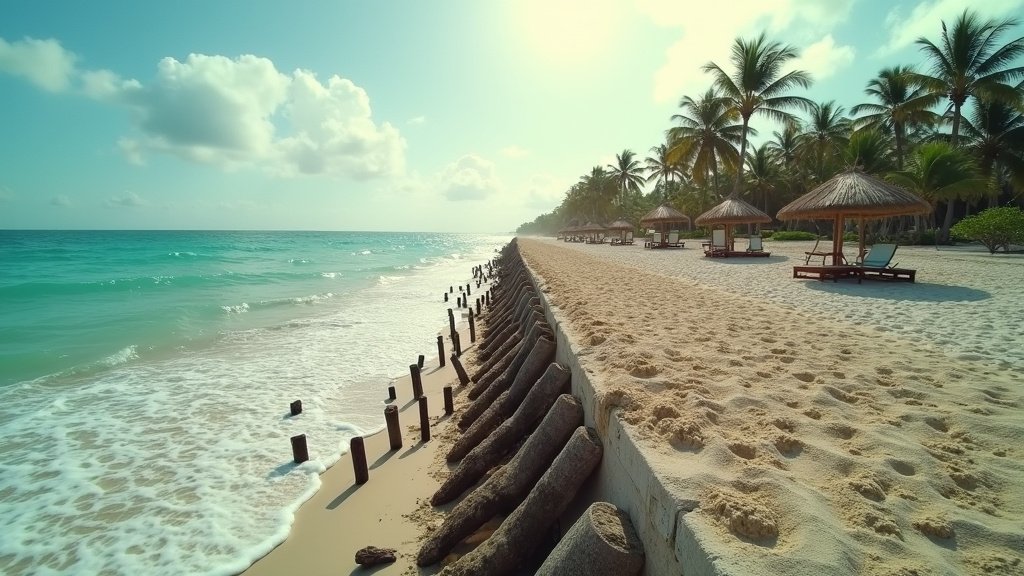The iconic sands of Seven Mile Beach, the jewel of the Cayman Islands’ tourism crown, are succumbing to a relentless tide of erosion, forcing a critical reassessment of the territory’s coastal management strategies. Recent actions, such as the Grand Cayman Marriott Resort’s beach restoration, signify a growing recognition of the escalating problem, but experts warn that piecemeal efforts are insufficient against a threat that impacts the islands’ environment, economy, and way of life.
The Vanishing Shoreline
Grand Cayman’s famed coastline is visibly shrinking. In areas like the southern stretch of Seven Mile Beach, waves now lap directly against seawalls and even buildings, a stark visual testament to the dramatic loss of beachfront over recent years. Studies indicate that the delicate balance of sand along the coast has been severely disrupted, with the natural movement of sand being overwhelmed by factors such as increased storm intensity and human-induced coastal development. The situation has been described by former officials as a “national environmental and economic emergency,” underscoring the urgency with which this crisis must be addressed.
The High Cost of Imported Sand
When natural sand resources dwindle, the only recourse is often costly importation. For Cayman, sourcing replenishment sand typically involves mining from the Bahama Banks. This sand, currently priced around US$100 per cubic metre, incurs significant additional expenses for shipping and trucking to the islands. When combined with contractor profit margins, the true cost of placing this vital material back onto the beaches can easily double, presenting a substantial financial hurdle. This challenge is compounded by a rising global demand for sand, driven by widespread coastal development and replenishment projects worldwide. The increasing competition for suitable sand reserves means that acquiring the necessary quantities at an acceptable price is becoming progressively difficult.
The Dying ‘Sand Factory’: Coral Reefs
Many marine biologists argue that the primary driver behind global sand erosion is the degradation of coral reefs. Healthy coral reefs serve a dual purpose: they act as natural breakwaters, absorbing significant wave energy that would otherwise batter and erode shorelines, and they function as vital “sand factories.” Through the growth of calcareous algae, these reefs naturally produce the fine sand that replenishes beaches. However, climate change impacts like rising ocean temperatures, acidification, and pollution are devastating these delicate ecosystems. As coral cover diminishes and structural complexity is lost, reefs become less effective at dissipating wave energy and produce less sand, exacerbating coastal erosion. The loss of branching corals like elkhorn and staghorn, once abundant in the Caribbean, has directly weakened natural coastal defenses.
Rebuilding Nature’s Defenses: Innovative Solutions
In response to this multifaceted crisis, innovative solutions are being explored. A prominent approach, championed by marine biologists such as Tom Goreau from Jamaica, involves the restoration of coral reefs using a technique known as “electrified reefs” or Mineral Accretion Technology (MAT). This method uses low-voltage electrical currents to accelerate the growth of mineral structures on submerged frames, essentially “growing” new limestone. These structures can then serve as a substrate for coral fragments, speeding up reef regeneration. As these new reefs grow and mature, they enhance biodiversity, act as effective breakwaters, and resume their role as natural sand producers. Trials of this technology have shown promise in various regions, offering a glimmer of hope for rebuilding these critical natural defenses.
A United Front for Coastal Resilience
The economic stakes are enormous, with Seven Mile Beach contributing an estimated US$1 billion annually to the Cayman Islands’ economy. Properties along the coast represent billions more in value, and continued erosion threatens tourism bookings, property values, and overall economic stability. While solutions like artificial beach nourishment and “sand engines” are being considered, the long-term resilience of Cayman’s beaches hinges on a comprehensive, coordinated strategy. This requires robust public-private partnerships involving the government, developers, and property owners, alongside a commitment to stronger coastal setback regulations and integrated shoreline management plans. The news from research and engineering reports points towards a clear, albeit challenging, path forward: investing in nature’s own protective systems is not merely an environmental imperative, but an economic necessity for the future of the Cayman Islands.

